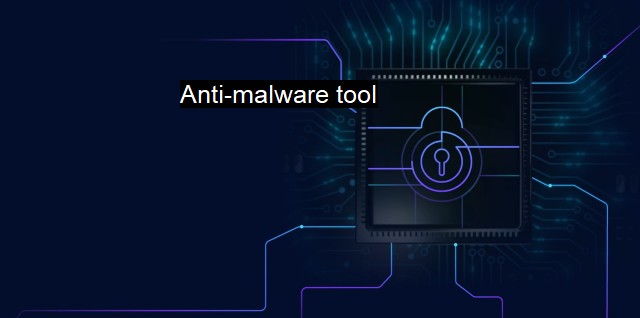What is Anti-malware tool?
The Importance of Anti-malware Tools in Cybersecurity: A Comprehensive Guide to Detection, Prevention, and Removal of Malicious Software
An anti-malware tool is an important element in the cybersecurity world that specifically focuses on detecting and eradicating malicious software or "malware" from a computer system. Malware represents a wide range of harmful or intrusive software, including computer viruses, ransomware, spyware, adware, Trojans, worms, and keyloggers. Therefore, having an effective anti-malware tool is crucial for computer users to ensure the safety and integrity of their digital spaces, whether for personal use or in a corporate setting.The fundamental purpose of an anti-malware tool or software is to scan, identify, and remove harmful programs that are present in a user's system. Ideally, it prevents these unwanted programs from embedding or executing entirely. Anti-malware tools perform these tasks by employing various approaches. Let's delve into how it does so.
The first technique is signature-based detection, where the anti-malware compares a dubious program in the system with an existing database of known harmful software. Once it detects a matching signature from this extensive library, it promptly removes or quarantines the malicious software. this method may not be successful in detecting newer types of malware that are not yet defined in the database.
To compensate for the limitations of signature-based detection, anti-malware tools also utilize heuristic analysis or behaviour-based detection. This methodology involves analyzing the behavior or attributes of an uncertain or suspicious program rather than relying on known problematic identifiers. By examining the qualities or patterns of behavior, the anti-malware tool can classify new or unknown types of malware.
In parallel, some advanced anti-malware tools also use sandbox technology. Herein, the suspicious programs are executed and tested in a safe, isolated environment within the system, thereby protecting the actual system from potential harm.
It's essential to keep the anti-malware tools updated, as new techniques and types of malware are consistently being developed by cybercriminals. The creators of anti-malware software regularly send updates to protect against the latest known threats, and using out-of-date software would expose the user to potential risks.
Proactive use of anti-malware tools forms an integral part of an overall cybersecurity strategy, as it is the first line of defense against most kinds of cyberattacks. In conjunction with other protective measures, such as firewalls and intrusion prevention systems, anti-malware tools provide a significant layer of security that can thwart various malware attacks.
Anti-malware tools do not just confer protection to home users but are equally beneficial to corporate environments. They form a part of the measures employed by companies to protect their IT infrastructure from harmful attacks that could lead to data breaches, financial losses, and significant damage to a company's reputation.
An anti-malware tool is an essential component for cybersecurity, designed to secure our systems from intrusive and destructive software. Given the exponential increase in the number of malware and complexity of cyber threats, it's no surprise that anti-malware software has evolved from a luxury or optional amenity to a necessity in today's digital age. Whether you are a general internet user using your computer for everyday tasks or a large organization with extensive networks, investing in a good anti-malware tool should be seen as a mandatory measure to ensure optimum cybersecurity.

Anti-malware tool FAQs
What is an anti-malware tool and how does it work?
An anti-malware tool is a cybersecurity software that detects, prevents, and removes malicious programs (malware) from a computer or network. It works by scanning the system for known malware signatures, behavior patterns, and anomalies that could indicate a potential threat. Once detected, the anti-malware tool can either quarantine or delete the infected files, or prompt the user to take action.What types of malware can an anti-malware tool protect against?
An anti-malware tool can protect against various types of malware, including viruses, trojans, worms, spyware, adware, ransomware, and rootkits. Some advanced anti-malware tools can also detect and prevent zero-day attacks, which are vulnerabilities and exploits that are unknown to the cybersecurity community or the software vendor.Should I rely solely on an anti-malware tool for my cybersecurity needs?
No, an anti-malware tool is just one layer of defense in a comprehensive cybersecurity strategy. It can only protect against known threats, and it may not detect sophisticated attacks or social engineering tactics. Therefore, it's important to supplement your anti-malware tool with other cybersecurity measures, such as firewalls, intrusion detection, data backup, user education, and software patches.How often should I update my anti-malware tool?
You should update your anti-malware tool on a regular basis, ideally daily or weekly. Updates include the latest malware signatures, bug fixes, and features that enhance the tool's performance and protection. Without updates, your anti-malware tool may miss new or evolving threats, leaving your system vulnerable to attack. Some anti-malware tools offer automatic updates, which ensure that you're always using the most up-to-date version without needing to manually check.| | A | | | B | | | C | | | D | | | E | | | F | | | G | | | H | | | I | | | J | | | K | | | L | | | M | |
| | N | | | O | | | P | | | Q | | | R | | | S | | | T | | | U | | | V | | | W | | | X | | | Y | | | Z | |
| | 1 | | | 2 | | | 3 | | | 4 | | | 7 | | | 8 | | |||||||